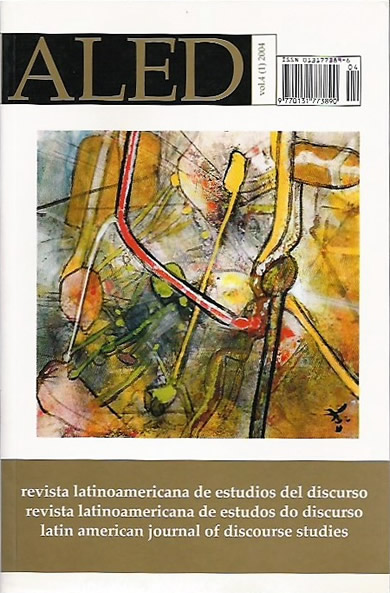La interacción en diálogos transmitidos por la radio en la frontera
Keywords:
conversations. complaints. radio. border. alignment. identity.Abstract
In this study we analyze conversations between radio talk show hosts and their listeners broadcast in Reynosa-Río Bravo, Tamaulipas and McAllen, Texas in February 2003. Our objectives are (a) to describe the structure for the macro-act of “complaints” according to the communicative projects of the participants (van Dijk:1991; Ruiz de Mendoza:2003); (b) to define the alignment strategies based on the positioning of the host and the listener as they communicate (Goffman, 1981; Linell, 1994; Koike, 2003); and (c) to analyze the identity construction of these particular talk as revealed in what the listeners and the hosts say. The study is informed by Ducrot and Anscombre (1983) regarding the presuppositions underlying all utterances and how they lead to a given comprehensibility by listeners, by Vila (2003) on the identity of those who live in the Mexican-United States border region, and poststructuralist concepts and the Theory of Chaos regarding the complexity of the object of study. The investigation finds that the dialogues on these radio programs reflect the political and social reality of both sides of the border. The dialogues are attempts at strengthening cultural and regional ties by the listeners of a given region, and show the construction and reconstruction of identities through the expression of attitudes of rejection of the ‘others’ across the border and a reinforcement of themselves on a particular side of the border. The conclusions lead us to question the notion of a “hybrid” reality of the border region as an entity in itself.
Downloads
References
ANZALDÚA, G. (1987). Borderlands/La Frontera: The New Mestiza. San Francisco: Aunt Lute Books. BAUDRILLARD, J. (1983). In the Shadow of the Silent Majorities. New York:Semiotext(e).
CALDERÓN, H. & SALDÃVAR, J. D. (eds.) (1991). Criticism in the Borderlands: Studiesin Chicano Literature, Culture, and Ideology. Durham, NC: Duke University Press.
DERRIDÁ, J. (1978). Writing and Difference. London: Routledge and Kegan Paul.
DUCROT, O. & ANSCOMBRE, Jean.-C. (1983). L’argumentation dans la langue.Bruxelles, Pierre Mardeaga, Editeur.
FOUCAULT, M. (1987). El orden del discurso. Versión española. Barcelona, Tusquetseditores.
FOUCAULT, M. (1982). La arqueología del saber. 8a. Edición. México, Siglo XXI.
GOFFMAN, E. (1981). Forms of Tallk. Philadelphia: University of PennsylvaniaPress.
GONZÁLEZ, J. (2000). Harvest of Empire: A History of Latinos in America. London:Viking.
GRAMSCI, A. (1991). Prison Notebooks. Ed. Joseph Buttigieg. New York: Colum-bia University Press.
HALL, S. (1991). “Introduction,” en Roger Simon, Gramsci’s Political Thought: AnIntroduction. London: Lawrence & Wishart.
HICK, D. E. (1991). Border Writing: The Multidimensional Text. Minneapolis:University of Minnesota Press.
JOHNSON, D. & MICHAELSEN, S. (eds.) (1997). Resketching Anglo-AmerindianIdentity Politics. Minneapolis: University of Minnesota Press.
KOIKE, D. A. (2003). La co-construcción del significado en español: elementos pragmáticos de la interacción dialógica. En Dale Koike, (ed.) La co-construcción del significado en el español de las Américas: Acercamientos discursivos. Pp. 11-23. Ottawa: Legas.
LINELL, P. (1994). Approaching dialogue. Amsterdam: John Benjamins.
PÊCHEUX, M. (1978). Hacia el análisis automático del discurso. Madrid, Gredos.
RODRÃGUEZ-ALFANO, L. & DURBORAW, C. A. (2003). “La co-construccióndel significado de la noción crisis en el diálogo de entrevistas de El habla de Monterrey”. En Dale Koike, (ed.) La co-construcción del significado en el español delas Américas: Acercamientos discursivos. pp. 71-111. Ottawa: Legas.
ROSALDO, R. (1987). Culture and Truth: The Remaking of SocialAnalysis. Boston: Beacon Press.
RUIZ DE MENDOZA IBÁÑEZ, F. J. (2003). Lingüística cognitiva: semántica, pragmá-tica y construcciones. [Documento en línea]. Disponible en: http://www.ucm.es/info/circulo/no8/ruiz.htm.
VAN DIJK, T. A. (1991). Estructuras y funciones del discurso.México: Siglo XXI.
VILA, P. (2003). Gender and the Overlapping of Region, Nation and Ethnicity onU.S.-Mexico Border. En Pablo Vila (ed.). Ethnography of the Border. University of Minnesota Press.
Downloads
Published
How to Cite
Issue
Section
License

This work is licensed under a Creative Commons Attribution-NonCommercial-NoDerivatives 4.0 International License.
The authors retain the copyright and guarantee RALED the right to be the first publication of the work as well as a Creative Commons Attribution License that allows others to share the work with recognition of authorship and the initial publication in this journal.




